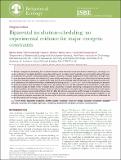Files in this item
Biparental incubation-scheduling : no experimental evidence for major energetic constraints
Item metadata
| dc.contributor.author | Bulla, M | |
| dc.contributor.author | Cresswell, Will | |
| dc.contributor.author | Rutten, A | |
| dc.contributor.author | Valcu, M | |
| dc.contributor.author | Kempenaers, B | |
| dc.date.accessioned | 2015-05-19T15:31:01Z | |
| dc.date.available | 2015-05-19T15:31:01Z | |
| dc.date.issued | 2015 | |
| dc.identifier | 134500015 | |
| dc.identifier | ed1333b4-4a43-4768-9936-7c15c4431acc | |
| dc.identifier | 84928401408 | |
| dc.identifier | 000351929300007 | |
| dc.identifier.citation | Bulla , M , Cresswell , W , Rutten , A , Valcu , M & Kempenaers , B 2015 , ' Biparental incubation-scheduling : no experimental evidence for major energetic constraints ' , Behavioral Ecology , vol. 26 , no. 1 , pp. 30-37 . https://doi.org/10.1093/beheco/aru156 | en |
| dc.identifier.issn | 1045-2249 | |
| dc.identifier.other | ORCID: /0000-0002-4684-7624/work/60426933 | |
| dc.identifier.uri | https://hdl.handle.net/10023/6670 | |
| dc.description.abstract | Incubation is energetically demanding, but it is debated whether these demands constrain incubation-scheduling (i.e., the length, constancy, and timing of incubation bouts) in cases where both parents incubate. Using 2 methods, we experimentally reduced the energetic demands of incubation in the semipalmated sandpiper, a biparental shorebird breeding in the harsh conditions of the high Arctic. First, we decreased the demands of incubation for 1 parent only by exchanging 1 of the 4 eggs for an artificial egg that heated up when the focal bird incubated. Second, we reanalyzed the data from the only published experimental study that has explicitly tested energetic constraints on incubation-scheduling in a biparentally incubating species (Cresswell et al. 2003). In this experiment, the energetic demands of incubation were decreased for both parents by insulating the nest cup. We expected that the treated birds, in both experiments, would change the length of their incubation bouts, if biparental incubation-scheduling is energetically constrained. However, we found no evidence that heating or insulation of the nest affected the length of incubation bouts: the combined effect of both experiments was an increase in bout length of 3.6min (95% CI: −33 to 40), which is equivalent to a 0.5% increase in the length of the average incubation bout. These results demonstrate that the observed biparental incubation-scheduling in semipalmated sandpipers is not primarily driven by energetic constraints and therefore by the state of the incubating bird, implying that we still do not understand the factors driving biparental incubation-scheduling. | |
| dc.format.extent | 871927 | |
| dc.language.iso | eng | |
| dc.relation.ispartof | Behavioral Ecology | en |
| dc.subject | Artic | en |
| dc.subject | Baparental incubation | en |
| dc.subject | Calidris pusilla | en |
| dc.subject | Constancy | en |
| dc.subject | Cross-over design | en |
| dc.subject | Energetic constraints | en |
| dc.subject | Energetic demands | en |
| dc.subject | Incubation bout length | en |
| dc.subject | Replication | en |
| dc.subject | Scheduling | en |
| dc.subject | Semipalmated sandpiper | en |
| dc.subject | Shorebird | en |
| dc.subject | Statistical power | en |
| dc.subject | QH301 Biology | en |
| dc.subject | DAS | en |
| dc.subject.lcc | QH301 | en |
| dc.title | Biparental incubation-scheduling : no experimental evidence for major energetic constraints | en |
| dc.type | Journal article | en |
| dc.contributor.institution | University of St Andrews. School of Biology | en |
| dc.contributor.institution | University of St Andrews. Scottish Oceans Institute | en |
| dc.contributor.institution | University of St Andrews. Institute of Behavioural and Neural Sciences | en |
| dc.contributor.institution | University of St Andrews. St Andrews Sustainability Institute | en |
| dc.contributor.institution | University of St Andrews. Centre for Biological Diversity | en |
| dc.identifier.doi | 10.1093/beheco/aru156 | |
| dc.description.status | Peer reviewed | en |
| dc.identifier.url | http://beheco.oxfordjournals.org/content/26/1/30/suppl/DC1 | en |
This item appears in the following Collection(s)
Items in the St Andrews Research Repository are protected by copyright, with all rights reserved, unless otherwise indicated.

